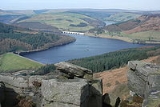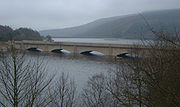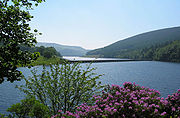
Ladybower Reservoir
Encyclopedia
Ladybower Reservoir is a large Y-shaped reservoir, the lowest of three in the Upper Derwent Valley
in Derbyshire
, England. The River Ashop
flows into the reservoir from the west; the River Derwent
flows south, initially through Howden Reservoir
, then Derwent Reservoir, and finally through Ladybower Reservoir. Its longest dimension is just over 3 miles (4.8 km), and at the time of construction it was the largest reservoir in Britain.
The area is now a popular tourist location, with the Fairholmes visitors' centre located at the northern tip of Ladybower.
 Ladybower was built between 1935 and 1943 by the Derwent Valley Water Board
Ladybower was built between 1935 and 1943 by the Derwent Valley Water Board
, and took a further two years to fill (1945). The dam differs from the other two as it is a clay-cored earth embankment, and not a solid masonry dam like the others. Below the dam is a cut-off trench 180 feet (54.9 m) deep and 6 feet (1.8 m) wide filled with concrete, stretching 500 feet (152.4 m) into the hills each side, to stop water leaking round the dam. The building of the dam wall was undertaken by the Scottish company of Richard Baillie and Sons. The two viaducts, Ashopton and Ladybower, needed to carry the trunk roads over the reservoir were built by the London firm of Holloways, using a steel frame clad in concrete. Both firms encountered mounting problems when the Second World War broke out in 1939 making labour and raw materials scarce. This extended the proposed build time, but the construction was carried on due to the strategic importance of maintaining supplies. The opening ceremony for the reservoir was carried out on Tuesday 25 September 1945 by King George VI accompanied by Queen Elizabeth
.
During the 1990s the wall was raised and strengthened to reduce the risk of 'over-topping' in a major flood. The original dam wall contains 100,000 tons of concrete, over one million tons of earth and 100,000 tons of clay
for the core, the upstream face being stone faced. Materials were brought in via the Derwent Valley Water Board's own branch line to the site and their sidings off the main line in the Hope Valley
.
The dam's design is peculiar in having two totally enclosed bellmouth overflows (locally named the 'plugholes') at the side of the wall. These are stone and of 80 feet (24.4 m) diameter with outlets of 15 feet (4.6 m) diameter that each discharges via its own valve house at the base of the dam. The overflows originally had walkways around them but they were dismantled many years ago.
 The water is used for river control and to compensate for the water retained by all three dams, along with supply into the drinking water system and hydroelectricity generation. Drinking water must be pumped to treatment works rather than using gravity flow like in the other two reservoirs, increasing costs. The drinking water is treated at Bamford
The water is used for river control and to compensate for the water retained by all three dams, along with supply into the drinking water system and hydroelectricity generation. Drinking water must be pumped to treatment works rather than using gravity flow like in the other two reservoirs, increasing costs. The drinking water is treated at Bamford
water treatment works by Severn Trent Water. Treated water flows down the 28 miles (45.1 km) long Derwent Valley Aqueduct to a covered service reservoir at Ambergate
to supply clean water to the cities of Derby
and Leicester
in the East Midlands
of England. The aqueduct passes through the park of Chatsworth House
on its way south. The path of the aqueduct is marked by a series of distinctive valve houses built of stone & domed steel access chambers. A tunnel carries some of the water from the Derwent Valley eastwards through the hill and into the lower of the two Rivelin Dams
in order to supply Sheffield.
and Derwent
(including Derwent Woodlands church and Derwent Hall). The buildings in Ashopton were demolished before the reservoir was filled, but much of the structure of Derwent village was still visible during a dry summer some 14 years later. The clock tower of the church had been left standing and the upper part of it was visible above the water level until 1947, when it was seen as a hazard and demolished with explosives.
Upper Derwent Valley
The Upper Derwent Valley is an area of the Peak District National Park in England. It largely lies in Derbyshire, but its north eastern area lies in Sheffield, South Yorkshire...
in Derbyshire
Derbyshire
Derbyshire is a county in the East Midlands of England. A substantial portion of the Peak District National Park lies within Derbyshire. The northern part of Derbyshire overlaps with the Pennines, a famous chain of hills and mountains. The county contains within its boundary of approx...
, England. The River Ashop
River Ashop
The River Ashop is a river in the Derbyshire Peak District, England. Its source is on Black Ashop Moor, just east of the Pennine Way, and north of Kinder Scout....
flows into the reservoir from the west; the River Derwent
River Derwent, Derbyshire
The Derwent is a river in the county of Derbyshire, England. It is 66 miles long and is a tributary of the River Trent which it joins south of Derby. For half its course, the river flows through the Peak District....
flows south, initially through Howden Reservoir
Howden Reservoir
The Howden Reservoir is a Y-shaped reservoir, top one of the three in the Upper Derwent Valley, England. The western half of the reservoir lies in Derbyshire, whereas the eastern half is in Sheffield, South Yorkshire. The county border runs through the middle of the reservoir, following the...
, then Derwent Reservoir, and finally through Ladybower Reservoir. Its longest dimension is just over 3 miles (4.8 km), and at the time of construction it was the largest reservoir in Britain.
The area is now a popular tourist location, with the Fairholmes visitors' centre located at the northern tip of Ladybower.
Design and construction

Derwent Valley Water Board
The Derwent Valley Water Board was constituted by Act of Parliament in 1899 to supply the cities of Derby, Leicester, Nottingham and Sheffield and the county of Derbyshire with water impounded by a series of reservoirs along the upper reaches of the River Derwent in the Peak District of...
, and took a further two years to fill (1945). The dam differs from the other two as it is a clay-cored earth embankment, and not a solid masonry dam like the others. Below the dam is a cut-off trench 180 feet (54.9 m) deep and 6 feet (1.8 m) wide filled with concrete, stretching 500 feet (152.4 m) into the hills each side, to stop water leaking round the dam. The building of the dam wall was undertaken by the Scottish company of Richard Baillie and Sons. The two viaducts, Ashopton and Ladybower, needed to carry the trunk roads over the reservoir were built by the London firm of Holloways, using a steel frame clad in concrete. Both firms encountered mounting problems when the Second World War broke out in 1939 making labour and raw materials scarce. This extended the proposed build time, but the construction was carried on due to the strategic importance of maintaining supplies. The opening ceremony for the reservoir was carried out on Tuesday 25 September 1945 by King George VI accompanied by Queen Elizabeth
Elizabeth Bowes-Lyon
Elizabeth Angela Marguerite Bowes-Lyon was the queen consort of King George VI from 1936 until her husband's death in 1952, after which she was known as Queen Elizabeth The Queen Mother, to avoid confusion with her daughter, Queen Elizabeth II...
.
During the 1990s the wall was raised and strengthened to reduce the risk of 'over-topping' in a major flood. The original dam wall contains 100,000 tons of concrete, over one million tons of earth and 100,000 tons of clay
Clay
Clay is a general term including many combinations of one or more clay minerals with traces of metal oxides and organic matter. Geologic clay deposits are mostly composed of phyllosilicate minerals containing variable amounts of water trapped in the mineral structure.- Formation :Clay minerals...
for the core, the upstream face being stone faced. Materials were brought in via the Derwent Valley Water Board's own branch line to the site and their sidings off the main line in the Hope Valley
Hope Valley
Hope Valley could refer to:*The Hope Valley, Derbyshire*The Hope Valley, Shropshire*Hope Valley, Rhode Island, a village*Hope Valley, Western Australia, a suburb of Perth*Hope Valley, South Australia, a suburb of Adelaide...
.
The dam's design is peculiar in having two totally enclosed bellmouth overflows (locally named the 'plugholes') at the side of the wall. These are stone and of 80 feet (24.4 m) diameter with outlets of 15 feet (4.6 m) diameter that each discharges via its own valve house at the base of the dam. The overflows originally had walkways around them but they were dismantled many years ago.
Water usage

Bamford
Bamford is a village in the Derbyshire Peak District, England, close to the River Derwent. To the north-east is Bamford Edge, and to the south-east the location of the water treatment works covering the Ladybower, Derwent and Howden Reservoirs. Though locally Bamford is described as being in the...
water treatment works by Severn Trent Water. Treated water flows down the 28 miles (45.1 km) long Derwent Valley Aqueduct to a covered service reservoir at Ambergate
Ambergate
Ambergate is a village in Derbyshire, England, where the River Amber joins the River Derwent.Until the early nineteenth century it was known as Toadmoor, with no more than a few artisans' cottages. The southerly half of the village was still shown as such on the Ordnance Survey's maps.It is about ...
to supply clean water to the cities of Derby
Derby
Derby , is a city and unitary authority in the East Midlands region of England. It lies upon the banks of the River Derwent and is located in the south of the ceremonial county of Derbyshire. In the 2001 census, the population of the city was 233,700, whilst that of the Derby Urban Area was 229,407...
and Leicester
Leicester
Leicester is a city and unitary authority in the East Midlands of England, and the county town of Leicestershire. The city lies on the River Soar and at the edge of the National Forest...
in the East Midlands
East Midlands
The East Midlands is one of the regions of England, consisting of most of the eastern half of the traditional region of the Midlands. It encompasses the combined area of Nottinghamshire, Derbyshire, Leicestershire, Rutland, Northamptonshire and most of Lincolnshire...
of England. The aqueduct passes through the park of Chatsworth House
Chatsworth House
Chatsworth House is a stately home in North Derbyshire, England, northeast of Bakewell and west of Chesterfield . It is the seat of the Duke of Devonshire, and has been home to his family, the Cavendish family, since Bess of Hardwick settled at Chatsworth in 1549.Standing on the east bank of the...
on its way south. The path of the aqueduct is marked by a series of distinctive valve houses built of stone & domed steel access chambers. A tunnel carries some of the water from the Derwent Valley eastwards through the hill and into the lower of the two Rivelin Dams
Rivelin Dams
Rivelin Dams are a pair of water storage reservoirs situated in the upper part of the Rivelin Valley, eight km west of Sheffield in South Yorkshire, England. The dams are owned by Yorkshire Water and provide water to 319,000 people as well as compensation water for the River Rivelin...
in order to supply Sheffield.
Ashopton Village
The building of the reservoir resulted in the 'drowning' of the villages of AshoptonAshopton
Ashopton was a village in Derbyshire, England, that was lost along with neighbouring Derwent when the Ladybower Reservoir was constructed in the late 1930s and early 1940s....
and Derwent
Derwent, Derbyshire
Derwent is a village 'drowned' under the Ladybower Reservoir in Derbyshire, England. The village of Ashopton, Derwent Woodlands church and Derwent Hall were also 'drowned' in the construction of the reservoir. There is no formal memorial to any of the villages...
(including Derwent Woodlands church and Derwent Hall). The buildings in Ashopton were demolished before the reservoir was filled, but much of the structure of Derwent village was still visible during a dry summer some 14 years later. The clock tower of the church had been left standing and the upper part of it was visible above the water level until 1947, when it was seen as a hazard and demolished with explosives.

